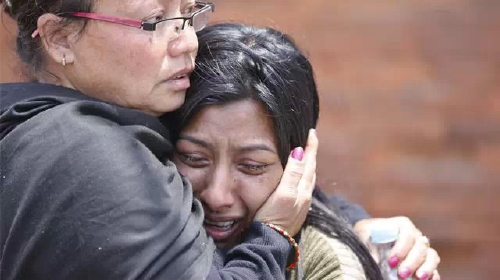作者:春风姑娘 2015-05-24

一位妇女正在哭泣,她的亲人死于星期六地震中,正准备在加德满都(尼泊尔首都)的一条河边进行火葬。
1991年, 普雅卡·乌尼雅 6岁,一场6.8级的地震爆发在它的家乡北卡什县,她的七位亲人在这场灾难中死亡。
“我正在和我的姐姐睡觉,突然我被母亲刺耳的尖叫和地面的震动所惊醒,周围的房子开始坍塌,我们拼命跑,但最终还是无人生还。”乌尼雅回忆道。
乌尼雅被碎石掩埋14个小时才被搜救到,那个时候,她还紧紧依偎着她已没有气息的姐姐。
“乌尼雅在被营救后的连续几周都没有讲话。一名邻居收留了她,并要她在营中跟随新“妈妈”,她歇斯底里的哭喊她的姐姐是不是没有了。”现年44岁的来自德拉顿的一名教师赫玛莱特·拉瓦特说,她现在在北卡什县的2个营地做义工。
一个月后,乌尼雅搬到了密鲁特(印度北部的一座城)她姑妈的家,现在她在那里生活并成为了一名护士。
“地震发生的那个晚上我难以忘怀,但是我却丝毫不能回忆营救时和之后发生的事情。但无论何时地面震动或电闪雷鸣时,我都感觉自己几乎不能呼吸,就像被活埋似的。”乌尼雅说。
自从悲剧发生后,她便再也没去过那座山,也没回她的家乡。
尼泊尔的这场7.9级地震导致超过6000人遇难,波及800万人,像乌尼雅这样的受害者不仅需要重建他们的生活,更需要治愈他们心理的创伤。
“在经历巨大的突发性危机事件时,很多人会出现急性应激障碍症,甚至会出现更为严重的症状——梦魇、失眠、焦虑、心悸、盗汗。当这一症状持续得不到缓解和治疗时,还会演变成创伤后应激障碍。”富通医院脑神经行为科学的医生萨米尔·帕里克如是说道。
心理阴影
创伤后应激障碍有以下特征:幻觉重现,梦魇,失眠,注意力涣散,过敏性休克和心理压力。
乌尼雅说,她现在就出现了创伤应急障碍症的一些典型的特征。
“她会选择性的去逃避一些让她触景生情的东西。生活中与创伤可能产生联系的任何事物,都可能引起个体对创伤情境的再体验。并且这种体验会给个体带来极大的痛苦。,个体会主动回避这些可能引发创伤体验和再体验的事物。”帕里克医生说。
联合国儿童机构曾报道,尼泊尔发生的灾难性地震导致近100万的儿童急需要帮助。
他们的家园在上星球六的地震中被摧毁后,数以千计的儿童不得不露营在尼泊尔的首都加德满都。与此同时,联合国儿童基金会也警惕着疾病的传播。
报告中说,生活在该地区的至少94万儿童受地震影响严重,他们急需要人道主义援助。
在健康系统和灾害管理国际期刊的2014年11月份的期刊报道,北卡什县一所高中268个年龄在14-16岁的受灾儿童,几乎三分之一(约32.8%)在地震发生3个月后,再次遭受心理创伤。
报道中突出强调对创伤后应激障碍治疗方法的需要,而这也是在资源匮乏型的发展中国家常常被忽视的。
泰米尔纳德邦政府宣称在2004年的海啸中,他们采用低成本的干预措施来帮助千万幸存的儿童直面灾难取得了成效。
联合国儿童基金与尼赫鲁肯德拉政府合作,用一些使人身心舒适的方法,如画蜡笔画、玩木偶、跳舞、唱歌、瑜伽来帮助孩子们战胜摧毁他们家乡和亲人的恶魔,一起渡过难关。
起初孩子们画的图片都是暗淡阴郁、阴云密布的天空,洪水泛滥的村庄,动物的尸体和连根拔起的树木——但12周之后,画面开始变得温暖,图画中出现了阳光,孩子们也逐渐回到沙滩上嬉戏,玩板球。
药物治疗
有时,心理治疗是不够的,适当的时候也需要服用镇静剂。镇静剂可以降低人体被称为皮质醇的荷尔蒙,它能够释放身体也能够缓解心理压力。
然而,新的研究表明,遵循身体的自然机制,让它慢慢愈合会更好。因为使用镇静剂会干扰大脑塑造记忆的能力。
欧洲神经心理药物期刊发布的文章中表明,苯二氮卓类药物,作为使用最广泛的镇静剂,它具有安神定气的作用,但却会打乱身体的平衡机制,不利于身体完全的康复。
印度一些出名的苯二氮卓的品牌,例如阿普唑仑、三唑仑等。
帕里克医生提到,服用镇静剂和安眠药的确可以短时间的减轻来自突发灾难的焦虑和痛苦,但是从长远看却不能真正根治心理的创伤。
安全感需要来自家人、朋友和社会更多的关爱。
翻译:张梦
校对:程思、隋双戈
【拓展阅读】
本文英文网址链接:
英文原文:
In quake-hit Nepal, victims need help to heal emotional scars
Sanchita Sharma, Hindustan Times, New Delhi
Updated: May 01, 2015 11:48 IST
Priyanka Uniyal was 6 years old when her home in Uttarkashi district collapsed and crushed her family of 7 in the 6.8 magnitude earthquake that hit Uttarakhand in 1991.
"I was asleep with my sister and woke up to my mother screaming and the earth shaking. The house was falling down around us, we ran, but everyone died," recalls Uniyal.
Uniyal was found buried under rubble 14 hours later, clinging to her lifeless sister.
"Priya did not speak for weeks after being rescued. A neighbour took her in and she took to following her new `mum` around the camp, crying hysterically if she lost sight of her," says Hemlata Rawat, 44, a schoolteacher from Dehradun who worked as a volunteer at two camps in Uttarkashi.
A month later, Uniyal moved in with her aunt in Meerut, where she now lives and works a nurse.
"That night is etched in my memory, but I do not recall the rescue or much of what happened immediately afterward. But whenever the earth shakes or there is thunder or sudden loud sound, I feel I cannot breathe. I feel buried alive," says Uniyal.
She has never visited the mountains or her village since the tragedy.
In Nepal where the 7.9 magnitude earthquake killed more than 6,000 and affected 8 million people, victims just like Uniyal will need help not only to rebuild their lives but assistance to heal emotional scars too.
"It is natural to be shaken after a dangerous event and most people develop acute stress disorder (ASD) with symptoms of shock, but even the very serious signs – nightmares, insomnia, anxiety, palpitation, getting up in cold sweat – do not last for more than a few weeks. It becomes post-traumatic stress disorder (PTSD) when the symptoms become chronic," says Dr Samir Parikh, head, mental health and behavioral sciences, Fortis Hospitals.
Psychological aftershocks
PTSD is characterised by flashbacks, nightmares, sleeplessness, difficulty concentrating and irritability following severe shock and mental stress.
Uniyal, he says, has the classic signs of PTSD.
"She is displaying `avoidance`, where the person stays away from reminders of the experience, and `re-experiencing`, where reminders make the person relive the trauma, including the physical symptoms and feelings they experienced when it was occurring," says Dr Parikh.
The United Nations` children`s agency has said almost 1 million children urgently need help after the deadly earthquake in Nepal.
With thousands of children camping out in the open in the capital Kathmandu after their homes were destroyed in last Saturday`s quake, Unicef warned of the risk of disease.
"At least 940,000 children living in areas severely affected by (the) earthquake in Nepal are in urgent need of humanitarian assistance," it said in a statement.
A study of 268 disaster-affected children aged 14-16 years in a high school in Uttarkashi district found that roughly one in three (32.8%) continued to suffer from trauma-related stress disorder after three months of the disaster, reported researchersfrom St John`s Medical College in The International Journal of Health System and Disaster Management in November 2014 .
The findings highlight the need for providing interventions for PTSD, which continues to be ignored in resource-strapped developing countries.
Low-cost interventions work and the Tamil Nadu government proved this when they helped thousands of child survivors face their nightmares and demons after the tsunami in 2004.
In partnership with Unicef and Nehru Yuva Kendra Sangathan, the government used crayons, puppets, dance, song and yoga to help children overcome the terror of the killer wave that wiped their families and home.
All images children drew initially were dark and gloomy – overcast skies, flooded villages, dead animals and uprooted trees – but by the end of 12 weeks, the sun started shining and the children were back playing cricket on the beach.
Prescription cure
At times, psychological support is not enough and sedatives are prescribed. Sedatives work by lowering levels of the human stress hormone called cortisol, which is released by the body in response to mental and physical stress.
New research, however, shows it is better to allow the body`s natural mechanism to slowly heal because sedatives interfere with the mind`s ability to consolidate memories and recover from flashbacks.
A study from the Jawaharlal Institute of Postgraduate Medical Education and Research (JIPMER), Puducherry, in the European Journal of Neuropsychopharmacology last year found that benzodiazepines, the most popular class of sedative that includes diazepam, interfere with the body`s natural coping mechanisms and hamper recovery.
Some popular brandnames for benzodiazepines in India are Alprax, Alprocontin, Anzilum; Pacyl, Restyl, Tranax, Xycalm and Zolam.
"Popping sedatives and sleeping pills to reduce anxiety after a traumatic experience may offer temporary relief, but it does not help you cope with trauma in the long run," says Dr Parikh.
"To feel safe, you need psychosocial support from your family, friends and community."
编辑:王锐
来源:春风心理应激干预